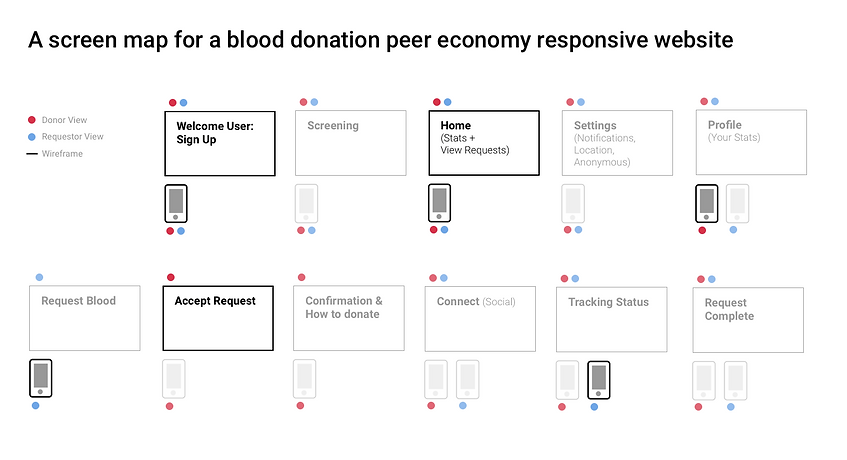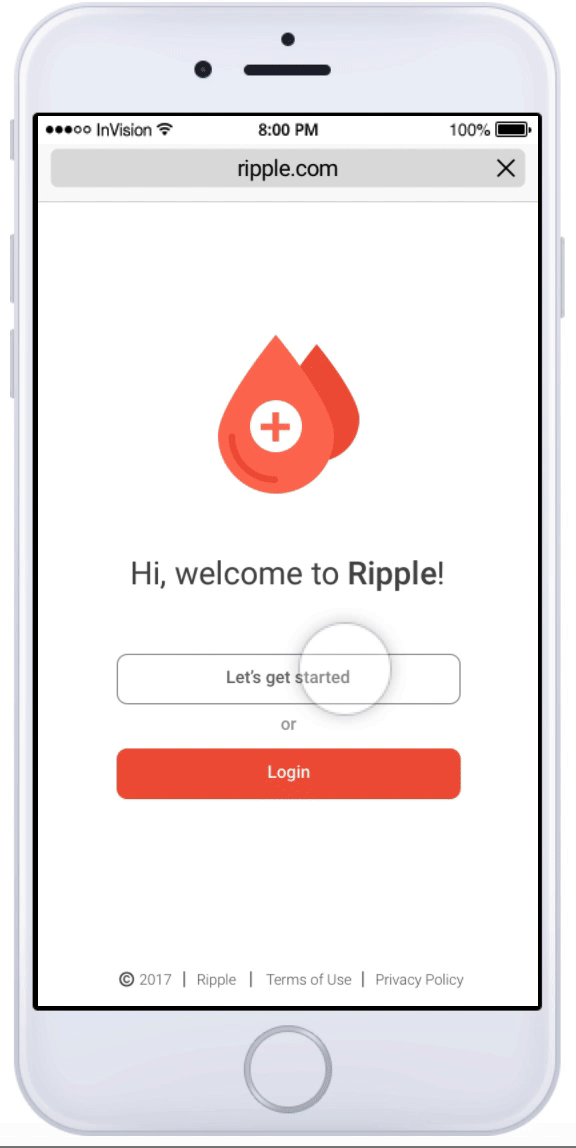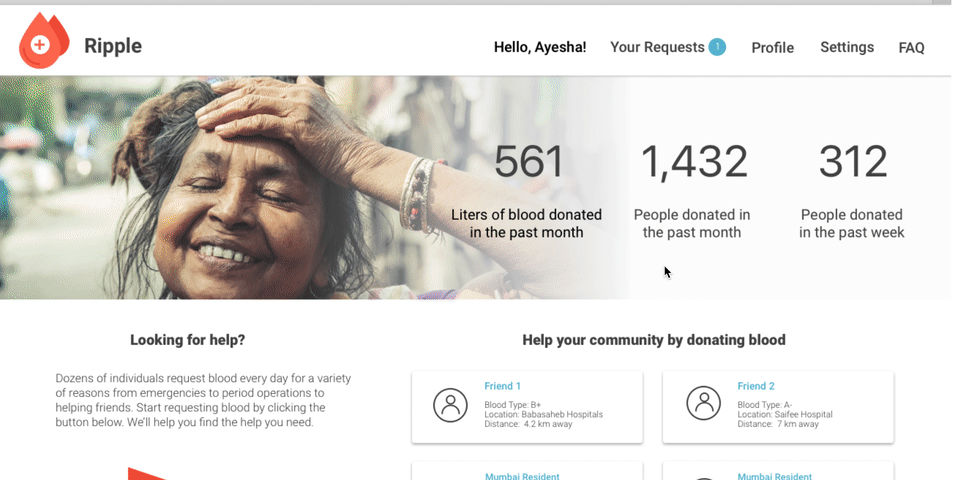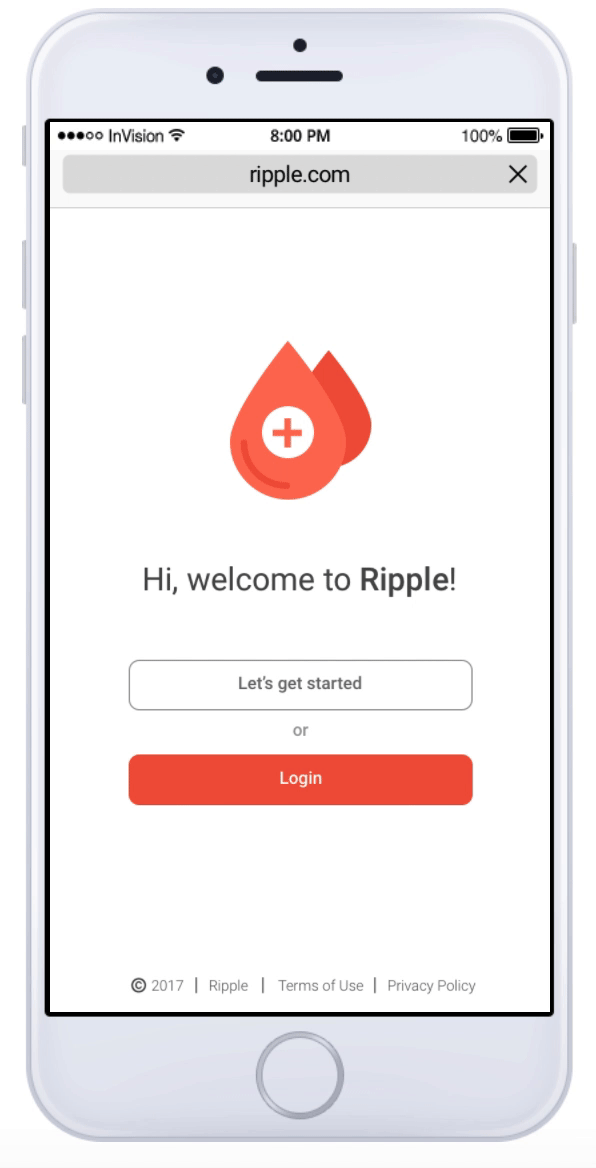
Ripple
A web based peer economy that helps connect donors and requesters.
How can we facilitate the need for safe blood in a timely manner in developing countries?
Why is this a problem?
Many of us donate blood voluntarily at blood donation camps and hospitals in the hope that it might help people in need. While this act may definitely be helpful, the impact is not quite the same as we expect it to be. We also never get to see the people whose lives we might have impacted.
In addition to this, there is a shortage of safe blood in developing countries.
How do we fix this?
In an effort to address this, Ripple will help donors, patients, and hospitals connect more easily, while maximizing a donor’s impact and increasing blood donations. Ripple creates a community and notifies nearby donors of blood requests.
Team: Shipra Arora, Tony Wang, Stephanie Valencia
Here's what we created
Mobile web version




Click to view full prototype
Desktop web version
Click to view full prototype




Ripple searches, notifies and connect thousands of blood donors. Connecting blood donors whether they are at home or on the go, reduces the time needed to find a donation, which in turn increases the possibility of saving lives and also eliminates the shortage of blood.

With ripple we onboard users through a screening process that makes sure we have eligible donors signed up.
If someone needs blood, they can create a post that includes information about where the blood is needed, contact information, the urgency, and an option to identify the blood group required, and an anecdote about the patient.
When that request is posted, those nearby who have indicated they’re willing to donate blood/specific groups (friends) will be sent a notification and given the option to respond and accept the request.
People who need the donations will be connected with donors who respond. Donors’ details are kept private unless they choose to disclose it to the person in need of blood.
Design Process
Domain
We decided to explore opportunities for a web-enabled peer economy in the medical and emergency response space. Our initial vision was in developing an economy to democratize access to devices or supplies crucial to health and wellbeing, using emerging technologies such as 3D printing.
We envisioned a responsive website where we could connect 3D printer owners with people who need customized items for medical purposes or medical emergencies. We then proceeded to do some research to weight the potential of our idea.
Guerrilla Research
To learn more about the domain space we conducted 23 interviews over the phone, email and in person to a random sample of people in our professional and social circles as well as medical professionals.
The interviews covered 3 main topics: 3D printing, medical emergencies and hospital supplies.

Insights
-
Half of the interview participants had 3D printed before, but generally only a small portion of people had 3D printed items at home.
-
Most of the interviewees were familiar with 3D printing for medical devices such as 3D printed organs.
-
More than half of the participants expressed feeling comfortable with the idea of using a 3D printed medical device.
-
Interviews revealed that hospitals have challenges with equipment access and maintenance. “Hospitals that are smaller and do not receive as much support from the government so they keep recycling old equipment but never have enough money to get new machines.”
The Drawing Board
Our research had pointed us to three opportunities in the design space:
1. Knowledge or technical support exchange
2. Medical supplies exchange between hospitals
3. Equipment loans
We realized that many of the services highlighted are currently being provided by certified medical equipment manufacturers. We reflected on ways we could bring these same concepts to impact people directly.
We identified two vulnerable populations that could really benefit from a peer economy that could make medical care more accessible such as people with disabilities and people in need of blood donations.
Narrowing down an economy
Through further domain research, we learned that there is a shortage of safe blood in developing countries, and patients and families needing blood will reach out on social media networks to locate donors.
We also learned that the average blood donation rate is more than 9 times greater in high-income countries than in low-income countries. Many patients who require blood transfusions do not have time access to safe blood.

Storyboarding and Speed-Dating



Insights
-
“I definitely see the need for this. I have friends and family that have faced this issue and did not get blood in time.”
-
“Only about 5% of actual donors are actually registered, this would be a good way to on- board people that could potentially donate.”
-
People were comfortable with the idea of opting in to a blood donation community that has data stored online.
-
A lot of illegal blood trade could be mitigated by this solution.
-
A major concern arose for the safety of the blood and the donor.
Interaction Flow and Screen Map
After collecting valuable feedback through our storyboard’s speed-dating activity we decided to design a responsive website with the following features:
• Sign-up with donor eligibility check.
• Back-end algorithms that would enable timely donation matches by location or social group.
• Social features that allow you to see who you can help and who have you helped or who has helped you.
• View pending request and Making a request.

With the purpose of planning a prototype for our blood donation website we created a screen map showing all the screens involved in the interaction. We highlighted which screens we would create both for the requester user role and the donor user role.

Lo-Fidelity Prototypes and Iterations
Mobile Version
We built our mobile wireframes first to follow an additive design process, in which we focused on core features in a limited amount of space. Our team discussed a number of issues, ranging from specific features on each page to how we wanted the initial UX to feel.

To ensure safety of blood, walk the user through a registration process that will conclude in a hospital visit to determine donor eligibility.
We introduced statistics on the home page in addition to allowing users to see their requests.
We decided on discrete categories for the request blood page in order to prevent input errors when a requester is facing an emergency. Dropdown menus aid requesters in recognition over recall.
Desktop Version
Our desktop version builds on the core functionality of the mobile website, but adds key features such as the use of maps in order to take advantage of the additional space.
Although the news feature did not make our final prototype, we initially conceived of a news section that would provide relevant medical and socially positive news in order to encourage donations.

Although requesters would be using the system at the scene of an emergency or in the hospital, donors could be logged in at home to more easily connect with a member of their community that needs blood.
A map would provide additional data to donors about how close a requester is and how easy it would be to donate at a nearby hospital.
This is the modal that pops up when a user is reading more about a request. It features a personal anecdote that displays an important message from the requester, in addition to key information such as blood type, time (urgency), and location on the right.
Final Design


Pilot City
The lack of blood in developing countries has been one of our key inspirations for this project. Our research proved that Mumbai has a large demographic that fits our target audience and the appropriate environment for Ripple’s deployment for the following reasons:
-
Internet and technology infrastructure
-
Large population
-
Need for blood
We hope to test this service there initially before expanding to other locations.
Possible Partnerships
Ripple’s purpose is to build communities that can rely on each other, the more people have in common, the easier they will connect. Therefore there is a great opportunity to partner with organizations, schools or companies, and city governments to integrate Ripple into their benefits, and community building resources. There is also great opportunity in using the Ripple platform to promote blood donation drives for emergencies.



